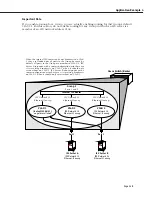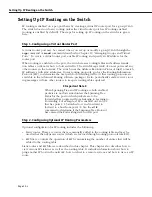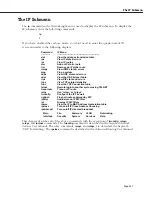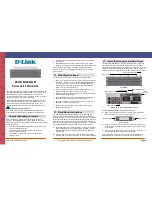
IP Routing Overview
Page 25-3
Transport Protocols
IP is both connectionless (it routes each datagram separately) and unreliable (it does not
guarantee delivery of datagrams). This means that a datagram may be damaged in transit, or
thrown away by a busy router, or simply never make it to its destination. The resolution of
these transit problems is to use a layer 4 transport protocol:
• Transmission Control Protocol (
TCP
)—A major data transport mechanism that provides reli-
able, connection-oriented, full-duplex data streams. While the role of
TCP
is to add reliabil-
ity to IP,
TCP
relies upon IP to do the actual delivering of datagrams.
• User Datagram Protocol (
UDP
)—A secondary transport-layer protocol that uses IP for deliv-
ery. However,
UDP
is not connection-oriented so it does not provide reliable end-to-end
delivery of datagrams. But some applications can safely use
UDP
to send datagrams that
don’t require the extra overhead added by
TCP
.
Application-Layer Protocols
• Bootstrap Protocol (
BOOTP
)/Dynamic Host Configuration Protocol (
DHCP
)—May be used
by an end station to obtain an IP address. The switch provides a
UDP
relay that allows
BOOTP
requests/replies to cross different networks. See Chapter 26, “UDP Forwarding.”
• Simple Network Management Protocol (
SNMP
)—Used to manage nodes on a network.
SNMP
is discussed in Chapter 13, “Configuring SNMP.”
• Telnet—Used for remote connection to a device. The
telnet
command is described in this
chapter.
• File Transfer Protocol (
FTP
)—Enables transferring files between hosts.
Additional IP Protocols
• Internet Control Message Protocol (
ICMP
)—Specifies the generation of error messages, test
packets, and informational messages related to IP.
ICMP
supports the
ping
command used
to determine if hosts are online.
• Address Resolution Protocol (ARP)—Used to find the IP address that corresponds to a
given physical (
MAC
) address.
• Internet Group Management Protocol (IGMP)—Tracks multicast group membership. See
the Multicast Services section of the
Advanced Routing User Manual
.
• Resource ReSerVation Protocol (RSVP)—Signals Quality of Service (QoS) requests in an IP
network. For more information, see the
Switched Network Services User Manual
.
Содержание Omni Switch/Router
Страница 1: ...Part No 060166 10 Rev C March 2005 Omni Switch Router User Manual Release 4 5 www alcatel com ...
Страница 4: ...page iv ...
Страница 110: ...WAN Modules Page 3 40 ...
Страница 156: ...UI Table Filtering Using Search and Filter Commands Page 4 46 ...
Страница 164: ...Using ZMODEM Page 5 8 ...
Страница 186: ...Displaying and Setting the Swap State Page 6 22 ...
Страница 202: ...Creating a New File System Page 7 16 ...
Страница 270: ...Displaying Secure Access Entries in the MPM Log Page 10 14 ...
Страница 430: ...OmniChannel Page 15 16 ...
Страница 496: ...Configuring Source Route to Transparent Bridging Page 17 48 ...
Страница 542: ...Dissimilar LAN Switching Capabilities Page 18 46 ...
Страница 646: ...Application Example DHCP Policies Page 20 30 ...
Страница 660: ...GMAP Page 21 14 ...
Страница 710: ...Viewing the Virtual Interface of Multicast VLANs Page 23 16 ...
Страница 722: ...Application Example 5 Page 24 12 ...
Страница 788: ...Viewing UDP Relay Statistics Page 26 24 ...
Страница 872: ...The WAN Port Software Menu Page 28 46 ...
Страница 960: ...Deleting a PPP Entity Page 30 22 ...
Страница 978: ...Displaying Link Status Page 31 18 ...
Страница 988: ...Displaying ISDN Configuration Entry Status Page 32 10 ...
Страница 1024: ...Backup Services Commands Page 34 14 ...
Страница 1062: ...Diagnostic Test Cable Schematics Page 36 24 ...
Страница 1072: ...Configuring a Switch with an MPX Page A 10 ...
Страница 1086: ...Page B 14 ...
Страница 1100: ...Page I 14 Index ...
















































